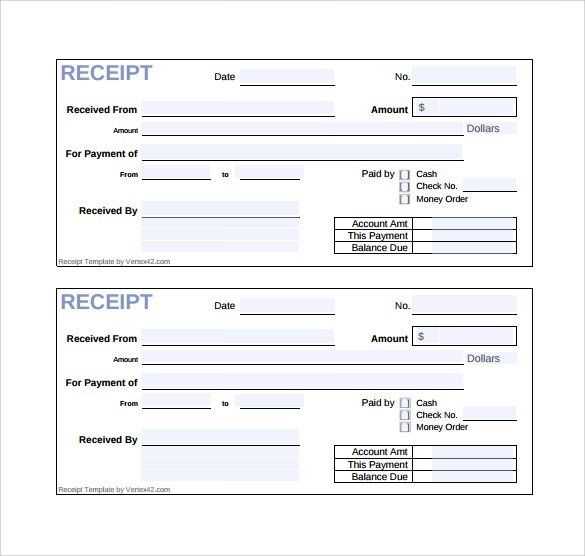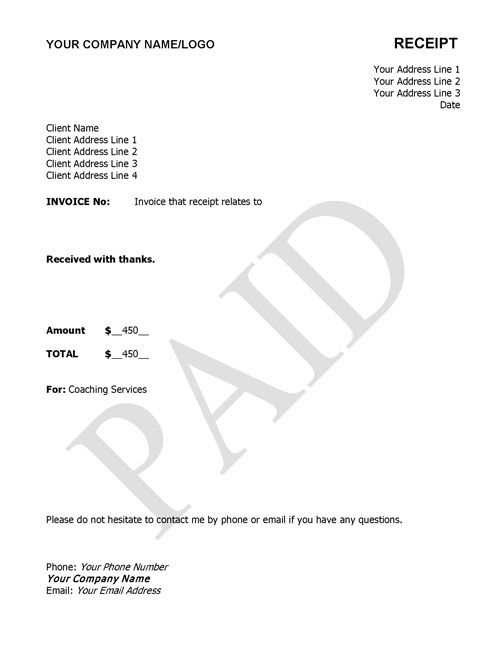
A coaching receipt template is a practical tool that ensures your clients receive clear and organized documentation for the services you provide. This simple, yet highly effective, document helps track payments and sessions, making it easy for both coaches and clients to maintain a professional record. By including key details such as session dates, amounts paid, and coaching goals, you create a transparent and efficient system for managing your business.
To create a functional coaching receipt template, include the following sections: the coach’s contact information, client’s name, the date of the session, service description, payment details, and any notes related to the coaching session. This format guarantees clarity and can be quickly customized to fit your specific needs. It’s crucial to ensure accuracy, as both clients and coaches depend on these receipts for financial records and any future references.
Utilizing a standardized receipt template streamlines administrative tasks and keeps your focus on what matters: delivering impactful coaching sessions. Whether you’re an independent coach or part of a larger organization, this tool allows you to build trust with your clients through clear, straightforward documentation.
Coaching Receipt Template: A Practical Guide
Creating a coaching receipt template is a straightforward process that ensures both you and your clients have accurate records of every session. Focus on clarity and consistency to help maintain professional documentation. Each receipt should include the following basic components: the date, client’s name, a brief description of services rendered, the payment amount, and any relevant session details.
Key Components of a Coaching Receipt

A complete coaching receipt must cover specific information that protects both parties. Include your contact details (name, email, and business address), the client’s name, and a clear breakdown of the services provided. Specify the date of the session, the session’s duration, and the payment amount. If the session involved a package or multiple meetings, note this as well for reference. This structure keeps things simple and avoids confusion.
Why Standardization Matters
Using a template for all your receipts promotes consistency and professionalism. Standardizing your receipts ensures no important detail is omitted, which can help avoid misunderstandings with clients. It also simplifies your record-keeping, making it easy to track payments over time. By creating a template that works for your business, you streamline administrative tasks, allowing you to focus more on coaching rather than paperwork.
Designing a Simple Template for Client Payments

Keep the design clear and easy to understand. A straightforward template helps your clients quickly locate key payment details, reducing confusion and improving communication.
Key Elements of the Payment Template
Start by listing the basic information you need: client details, service description, payment amount, and payment due date. Include a unique invoice number for easy tracking and a payment method section for your clients to choose from.
Structure Example
A clean, organized layout will ensure the client knows where to find the details. Below is an example template structure:
| Section | Details |
|---|---|
| Client Name | [Client’s Full Name] |
| Invoice Number | [Unique Invoice ID] |
| Service Description | [Description of Service Provided] |
| Payment Amount | [Total Amount Due] |
| Payment Due Date | [Due Date] |
| Payment Method | [Bank Transfer / Credit Card / PayPal / Other] |
| Notes | [Any additional details or instructions] |
Make sure to use bold fonts for key areas, like payment amount and due date, to help these items stand out. If possible, offer payment options to make the process as simple as possible for the client.
Key Elements to Include in a Coaching Receipt

Ensure the coaching receipt includes the following details for clear and professional documentation:
1. Coach and Client Information
Include the full name, contact details, and address of both the coach and client. This identifies both parties involved and helps with future communication.
2. Date of Session
Clearly list the exact date of the coaching session. This ensures both parties can track when services were provided.
3. Description of Services
Provide a brief but precise description of the services rendered. Specify the type of coaching (e.g., career, life, executive), session length, and the goals addressed during the session.
4. Session Fee
State the exact cost for the session or program. If there are any taxes or additional fees, list those separately. This avoids confusion regarding payment expectations.
5. Payment Method
Clarify how the payment was made (e.g., credit card, bank transfer, cash) to keep records transparent. If the payment is pending, indicate the due date for payment.
6. Receipt Number
Assign a unique receipt number for easy reference. This can be useful for both accounting and tracking payments.
7. Signature
Both the coach and the client should sign the receipt. This confirms that both parties agree to the terms outlined in the document.
8. Terms and Conditions
Include a brief section about the terms of the coaching arrangement, such as cancellation policies, payment deadlines, or any other relevant agreements.
9. Follow-up Details
If applicable, note any follow-up actions or next steps that are required, such as scheduling future sessions or completing tasks discussed during the session.
How to Customize the Receipt for Different Coaching Sessions
Tailor your coaching receipts based on the specific session type to maintain clarity and professionalism. Here are key tips for adjusting the format to suit different coaching services:
- Include Session Type: For individual coaching, specify the focus (e.g., career coaching, life coaching). For group sessions, note the number of participants and the collective topic.
- Specify Duration: Adjust the receipt according to session length. List both the total hours and the hourly rate, if applicable, especially for extended or short sessions.
- Provide a Breakdown of Fees: If applicable, list any additional charges, such as follow-up emails, special resources, or personalized materials. This transparency helps clients understand the value provided.
- Differentiate Between Packages: For clients who purchase multiple sessions, highlight any discount or package deal. Include the number of sessions, the total cost, and any applicable promotions.
- Payment Method: Always include the payment method (e.g., credit card, bank transfer) and transaction details to ensure the receipt’s accuracy. This is especially useful for clients with ongoing payments.
- Personalized Notes: If you offer customized coaching plans or bonus resources, reflect this in the receipt. Add notes about specific materials given or milestones achieved.
By adjusting these elements, clients will have clear and accurate receipts that match the service they received, increasing trust and satisfaction with your coaching business.


